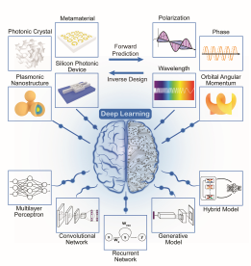| Our group and a few others have pioneered to apply artificial intelligence, including deep learning, in photonic design tasks. In sharp contrast with the conventional physics- or rule-based approaches, the unique advantages of deep learning lie in its nature of data-driven methodology that allows the deep learning model to automatically discover the highly nonlinear and non-intuitive structure-property relationship from a huge amount of data. Therefore, it offers an alternative yet powerful tool to rationally design various photonic structures, devices, and systems with on-demand spectral, temporal, angular, nonlinear, and quantum responses. By interfacing photonics with artificial intelligence, we can push the capacity of all-optical computing, communications, encryption, and data storage to an unprescendented level. |
 |

